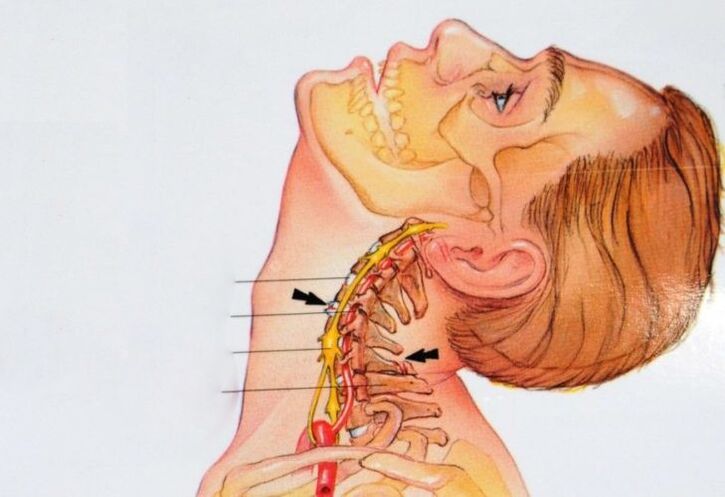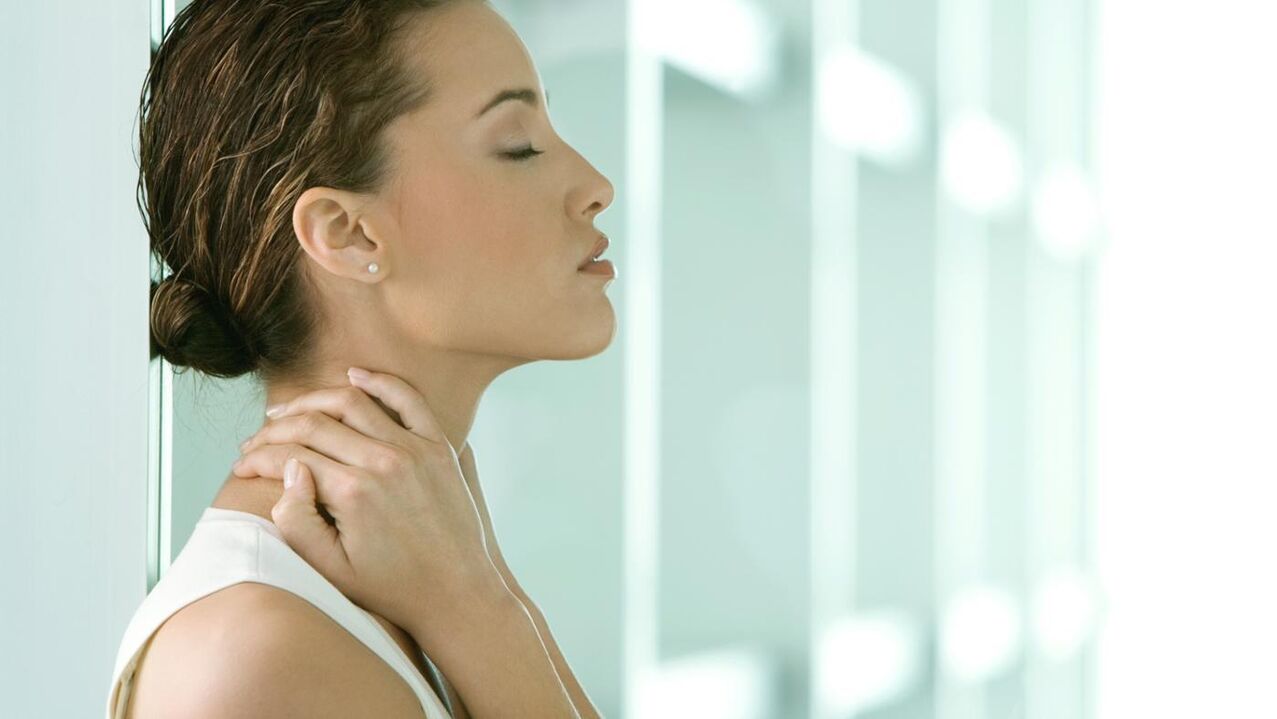Osteochondrosis of the cervix is a disease characterized by damage to the intervertebral discs.
Cervical osteochondrosis is one of the most common diseases in the world. Statistically, about 60% of the world's population has experienced it because modern people experience physical inactivity and also spend a lot of time in sedentary work. Osteochondrosis manifests itself as damage to the intervertebral cartilage as well as reactive processes in the surrounding tissues.
The vertebrae of the cervical spine are much smaller than the vertebrae of other vertebrae, but the load on them is not less. We are constantly turning ourselves around, leaving the neck in systematic motion. At the initial stage the disease is difficult to diagnose and the main manifestations of the disease are often ignored by patients. The result is the onset of cervical osteochondrosis, which significantly complicates the post-treatment process.
The modern clinic successfully treats osteochondrosis of the neck using non-surgical methods of correction and kinesiotherapy.

Causes of neck osteochondrosis
There are several factors that contribute to the development of osteochondrosis:
- Physical inactivity is a major cause that precedes the development of a dangerous disease. Complete absence of moderate physical activity leads to musculoskeletal degradation. Inadequate daily activity is not just a problem for office workers and drivers. People who prefer to spend their free time at the computer or watching TV experience hypodynamics.
- Excessive physical activity. This is most often experienced by professional athletes who are exposed to axial loads on the back. Working at the edge of capacity is also a threat to novice athletes who train without the supervision of a professional coach and perform exercises with incorrectly installed equipment.
- Negative factors of posture are walking in high-heeled and uncomfortable shoes, scoliosis, flat feet, as well as incorrect body position during sleep.
- Excess weight puts too much strain on the spine, causing the spine to move and the cartilaginous structures to wear out.
- Rheumatism.
- Disorders of the endocrine system.
- ᲡTress.
- Neck hypothermia.
- Sedentary lifestyle (such as drivers and office workers) or excessive physical activity (such as athletes).
Typically, these factors influence the load on the cervical spine, leading to muscle spasm. As a result, the circulatory process is disrupted and metabolism is impaired, leading to degenerative changes.
Interesting fact: The risk of developing a disease such as osteochondrosis is largely associated with evolutionary changes in the human body. There is talk of walking upright. Throughout the life cycle, the spinal column acts as the "nucleus" of our body. The vertebrae gradually press on the cartilaginous discs, causing the connective tissue to disintegrate, which is why osteochondrosis often manifests itself in old age.
The symptoms and treatment of cervical osteochondrosis will largely depend on the causes that led to the onset of the disease. Doctors conduct a number of examinations to develop an individual therapeutic plan. Self-medication for neck pain is strictly prohibited. Improper massages, medications or traditional medicine methods can make the situation worse and lead to irreparable consequences!

Cervical osteochondrosis: symptoms and treatment
Manifestations of dangerous disease depend on 2 main factors:
- Type of load on the cervical spine.
- The site of damage to the cartilaginous structure of the intervertebral disc.
Nerve roots perform a large number of functions, therefore the symptoms of damage to individual parts of them can vary considerably. In addition, you need to consider the stage of development of the disease. There are 4 of them, each of which is heavier than the previous one.
Cervical osteochondrosis 1 degree
This degree is called preclinical and is poorly expressed, which is why patients attribute the symptoms to stress, lack of sleep, and other seemingly non-serious problems. The spine begins to protect itself from "destructive" movements and excessive stress, so people begin to feel discomfort.
The main symptoms are:
- headache
- Discomfort in the neck, shoulders and arms
- Decreased light vision
- Slight decrease in motor activity of the neck
One of the most noticeable symptoms of the preclinical stage of cervical osteochondrosis is constant tension in the neck muscles. The muscles load quickly, causing excruciating pain as well as cramping when turning / tilting.
Since the above problems do not cause much discomfort, most patients prefer to allow the situation to take their course. In fact, it is already necessary to start treatment for cervical osteochondrosis, because the earlier the therapy is started the more effective it will be.
Grade 2 cervical osteochondrosis
In this case, patients begin to notice noticeable pain when tilting / turning. Often uncomfortable sensations extend to the arms, shoulder joints, and hands. Problems with the state of the nervous system begin: a person becomes irritable, meaningless, his daily ability to work is significantly reduced. The main symptoms of cervical osteochondrosis in women are almost identical to the symptoms of reproductive system problems (weakness, fatigue, apathetic mood and many others).
Despite the obvious signs of disease development, it is still possible to escape from neck osteochondrosis. First and foremost, doctors work to eliminate the risk of developing a hernia, which leads to impaired limb mobility and blood supply to the brain.
The main symptoms are:
- Severe neck pain
- Noise in the ears
- Impaired vision
- Decreased skin sensitivity of the shoulders and arms
- Deterioration of tendon reflexes
Cervical osteochondrosis 3 degrees
At this stage of development the disease is already considered neglected. Stage 3 of cervical osteochondrosis is more difficult to treat because the destruction / deformation of cartilaginous structures is often irreversible. Exacerbates the pain syndrome associated with the active development of hernias and friction of the bone tissues of the spine against each other.
In addition to pain, the patient experiences weakness and complains of dizziness. The reason for this is the disruption of large vessels and nerves leading to the spine. The brain receives insufficient amounts of food and oxygen, which can lead to blurred consciousness. Pain radiates to the upper extremities, there is a feeling of weakness in the arms. Another obvious sign of grade 3 osteochondrosis is loss of sensitivity of the fingers, as well as tingling in them.
The main symptoms are:
- Increased pain
- Cervical spine hernia
- Very weak tendon reflexes
- Paralysis of the upper extremities
Cervical osteochondrosis 4th degree
The cartilaginous tissues of the intervertebral discs have already undergone major changes due to destruction. In stage 4 of the disease in 99% of cases there is a rash and a hernia, which has a significant negative impact on the patient's condition. The body begins to heal independently and "builds up" tissue in areas of disc damage, resulting in the column itself losing its mobility.
When nerves and blood vessels contract, a person loses coordination of movements. Drowsiness, apathy and pain only get worse. Patients often complain of annoying tinnitus. In addition, stage 4 cervical osteochondrosis threatens the following outcomes:
- Cerebral ischemia, risk of developing spinal stroke. This is caused by strong compression of the vertebral arteries.
- Disruption of perception of the surrounding world and systematic loss of consciousness. The reason is the narrowing of blood vessels and insufficient blood supply to the cerebral cortex.
- Fatal outcome. A devastating result can occur as a result of spinal cord strain.
The main symptoms are:
- Depression of brain activity
- Lack of coordination
- Increased dizziness
- Paralysis
- Loss of hearing and sight
- Angina pectoris, shortness of breath
How to Cervical Osteochondrosis: Diagnostic Stage
Before eliminating the disease, doctors conduct a comprehensive examination of the patient's cervix. This is necessary to determine the presence of the disease and the fact of neglect. Diagnosis consists of several stages:
- X-ray. This is a visual way to determine the location of the spine, as well as to determine changes in their mobility.
- Laboratory research. With the help of tests, doctors diagnose spinal disorders, as well as make a final diagnosis.
- CT. It is a modern technique for assessing intervertebral disc fractures and height changes. Also, computed tomography helps to determine the instability of a particular spine.
- MRI. The presented stage of the examination is carried out to determine the condition of the nerve roots, the quality of blood circulation, as well as pathological changes in the cartilage / bone structures.
- Differential diagnosis. This includes ultrasound scans, cardiograms, and several other procedures. They are essential to prevent osteochondrosis from being confused with other diseases that have identical symptoms. These include diseases of the genitourinary system, all kinds of deformities of the spinal column, injuries of the thighs, as well as disorders of the central nervous system.
Identifying and treating the symptoms of cervical osteochondrosis is impossible without a comprehensive diagnosis. The earlier it is conducted, the more effective the therapy will be. If you notice symptoms of the disease, consult your doctor as soon as possible. He will give recommendations for meeting with narrow profile specialists: neurologist and orthopedist. In some cases it may be necessary to consult a cardiologist if the signs of the disease coincide with suspicious angina or ischemia of the heart muscle.

Diagnosis and successful treatment of neck osteochondrosis in modern clinics is based on the use of kinesitherapy. With the help of this healing technique, patients who perform a set of physical exercises on special exercise machines for recovery, significantly improve their health.
Basic methods of treating cervical osteochondrosis in women and men
Achieving high quality and stable results in the treatment of cervical osteochondrosis is possible only with an integrated approach to the problem. The effectiveness of recovery largely depends on the mood of the patient who will have to completely reconsider their lifestyle, diet, sleep and wakefulness.
By no means is it possible to treat osteochondrosis of the cervix independently in women and men, as the main symptoms of the disease may indicate the development of a completely different disease. Medications selected without the knowledge of a physician can seriously aggravate the situation. Even the elementary intake of painkillers does not always give the expected effect, which once again confirms the need for prior consultation with a specialist.
Eliminate pain aggravation
The disease often manifests itself as a painful, excruciating, and attractive pain syndrome. The main task of the doctor is to alleviate your suffering, so, first of all, specialists will prescribe:
- Anti-inflammatory drugs;
- Vitamins;
- Painkillers;
- Chondroprotectors.
The last category of drugs is aimed at restoring cartilage structures, which is especially important in the advanced stages of the disease. In addition, patients are prescribed medications to relieve muscle spasms and improve blood flow to the body.
Therapeutic gymnastics exercises
Physiotherapists know how to get rid of cervical osteochondrosis in the most affordable ways. Exercise therapy is one of the most effective methods of treating osteochondrosis, which can be used even at home. Exercise intensity plays no role in this case. Regular moderate physical activity will help to achieve the result. Here is the effect of exercise:
- Strengthen the neck muscles that are responsible for supporting the weakened spine.
- Stimulate and normalize blood supply to the body, which is especially important for the cerebral cortex.
- Raise general tone, charge energy, restore a person's productivity and ability to work.
Exercise therapy lessons are allowed daily. The set of exercises includes all types of head rotation and inclination. With proper level of physical exercise, the level of difficulty increases and the hand movement is related to the work. The advantage of therapeutic gymnastics elements is that they can be used even in the workplace. But remember that they can be carried out only after the elimination of acute pain syndrome.
As an additional load, doctors recommend that patients visit the pool as swimming relieves stress on the spine and relieves stress from the intervertebral discs. Shown and work with light hinges to strengthen the shoulder girdle.
Physiotherapy
The methods of physiotherapy are various:
- Electrophoresis.
- Magnetic, laser and shock wave therapy.
- Mud therapy.
- Healing baths and showers.
The above are just the basic therapeutic methods aimed at restoring the blood supply to the affected spine, eliminating inflammation, pain and slowing down the neck ossification process.
ᲛMassage
Treatment of cervical osteochondrosis with massages is common all over the world. But this method should be used with great caution, as rough and improper exposure to the damaged parts of the neck can lead to worsening of the condition. You should consult your doctor before making an appointment with a masseur.
Due to the influence of the hands on the painful area, the muscle tone decreases, which leads to the removal of painful spasms. It also improves blood circulation, restores clarity of thought and general well-being of the patient.
Surgery
The last stage of the disease leads to the formation of serious intervertebral hernias, as well as narrowing of the lumbar spine. Treatment of the patient in this case may require surgical intervention. The surgeon decides whether surgery is needed. It also defines a set of preparatory measures, a period of postoperative recovery and rehabilitation.
Most surgical interventions involve removing the resulting hernia as well as replacing the damaged spine.
Treatment of cervical osteochondrosis in the clinic
Treatment of osteochondrosis of the cervical spine in a professional clinic involves the use of exclusively non-surgical methods. Specialists work with unique techniques based on the principles of kinesiotherapy. Patients who seek help are treated in a specially equipped room with a set of physical exercises.
Osteochondrosis of the cervix is treated according to an individually designed program. The therapeutic effect is not only on a specific part of the spinal column, but also on the internal organs. The drug-free and non-surgical treatment process is difficult, but we provide comprehensive support to patients, helping them become more decisive and rethink their attitudes towards their own illness.
The healing process is built from here:
- Trainings in the rehabilitation room at least 2-3 times a week.
- In Parterre Therapeutic Gymnastics.
- Thermotherapy according to individual indications.
- Relieve pain with ice massage.
- Therapeutic / restorative massage.
- Adaptive exercises for work at home.
- Ultrasound microanatomical studies for follow-up of recovery over time.
- Personal consultations with specialists of the Kinotherapy Therapy Clinic.

Prevention of osteochondrosis
Treatment of cervical osteochondrosis in the context of modern medicine involves many effective methods. But it is much better not to allow this problem at all than to eliminate it. There is a set of preventive measures that will minimize the risk of developing and developing a dangerous disease:
- Take a 10-minute hot shower daily. Regular visits to baths / saunas are also recommended. Please note that these recommendations are only for people who do not have cardiovascular health problems.
- Go swimming and take regular walks in the fresh air at a leisurely pace. Physical inactivity is one of the leading causes of diseases of the musculoskeletal system.
- Avoid excessive physical activity to the best of your ability. This is especially true when working out in gyms. Critical axial loads on the spine cause protrusion.
- Try to avoid back injuries, especially if you are over 30 years old.
- Review your diet. Try to avoid moderate intake of confectionery, flour, salt and sugar. Reducing the caloric content of food allows you to avoid excess weight, which puts extra stress on the spinal column.
- If you work in an office and spend a lot of time with the computer, take care to buy a special chair with a waist and neck support. Try to do basic warm-up exercises every 60 minutes.
- If pain appears after waking up, consider purchasing an orthopedic mattress and pillow. If possible, take the bed with a flat, solid surface.
- To prevent degenerative and dystrophic changes of the cervical spine, visit a professional masseur at least 2-3 times a year. Neck and neck massage is one of the most effective preventive measures.
- Women should reduce walking on high heels as this interferes with the natural condition of the spine. In the case of flat feet, it is recommended to buy special shoes or soles, because orthopedic products correct the position of the foot and relieve unnecessary stress on the spine.
As well as:
- You should visit the bathroom regularly
- You should avoid bodybuilding, which can contribute to the protrusion of the cervical disc.
- Gentle exercise can be a good prevention of disease
Result
Treatment of osteochondrosis in a professional clinic is carried out under the strict supervision of highly qualified specialists. Physicians take an integrated approach when working with patients and deal with even the advanced stages of the disease. If you notice symptoms of osteochondrosis, you do not need to endure, self-medicate and postpone a visit to the doctor. Start your journey to a healthy, happy life!

















































